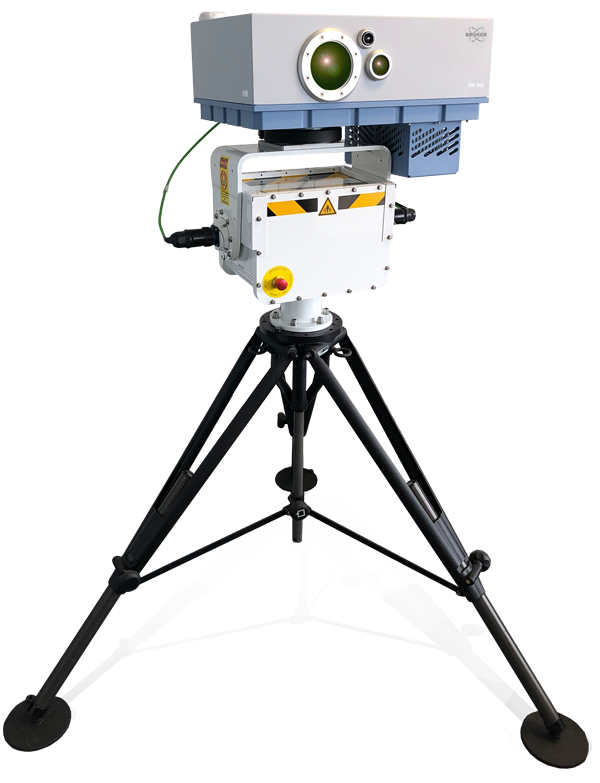HI 90
THE Hyperspectral Imager for Remote Gas Sensing


See the Invisible Danger from a Safe Distance
When dealing with chemical accidents or gas leakages, first responders need to know the location and composition of the potentially dangerous gas cloud while maintaining a safe distance. HI 90 is the preeminent tool for simultaneously revealing these two critical pieces of information accurately, rapidly, and automatically, even from several kilometers away.
HI 90 is a FT-IR spectrometer combined with a cryocooled focal plane array (FPA) detector. By analyzing the measured mid-infrared (MIR) spectrum from each pixel of the FPA detector, a real-time identification and visualization of the invisible gas clouds is provided.
Free to Measure in Any Direction
HI 90 measures thermal radiation emitted from matter in the measurement direction, which serves as the infrared light source for HI 90 to analyze. This includes thermal radiation emitted from any clouds of gas in the measurement direction. As a result, no artificial light sources or reflecting surfaces are needed. HI 90 is thus a “passive” remote sensing system and is free to measure in any direction the user chooses.
Rapid Identification and Visualization
The measured MIR spectrum from every pixel is compared in real-time to the reference spectra of the gas compounds in HI 90’s real-time spectral library. If a pixel’s measured spectrum fits the reference spectrum of one specific gas, it is color coded to indicate that this gas was identified. This false coloring image (i.e., chemical image) is overlaid on a video image of the measurement area to visualize the gas cloud. This chemical image evolves in real time as HI 90 can collect and analyze over 16,000 spectra in under 3 seconds.
Ultra-High Sensitivity
By combining Bruker’s actively aligned plane-mirror interferometer, cryocooled FPA detector, and dedicated remote sensing software, HI 90 offers ultra-high sensitivity.
For example, HI 90 can easily identify and visualize small gas clouds such as ethanol evaporated from disinfection gel applied to a hand or emitted from the fermentation of doughs in a bakery.
(right: signal-to-noise ratio image of ethanol cloud).
Large Library of Reference Spectra
Unlike laser- or filter-based systems, HI 90 measures the infrared spectrum with high spectral resolution over a large spectral range. This permits the unambiguous identification of gas compounds and avoids the need to narrow down the library to a small amount of target compounds.
The spectral library of HI 90 contains more than 40 compounds. If the IR signature of a compound is present in any of the spectra (over 16,000) that are taken during a single measurement (under 3 seconds), this chemical will be identified immediately. Additionally, Bruker offers an extended library as an option, which contains more than 290 compounds. This library can be used for post-analysis searching.
Automated Positioning for Monitoring
The motorized pan-tilt head of HI 90 can be precisely controlled and programmed in HI 90’s control software, OPUS RS, for automated surveillance at high-profile events and long-term monitoring at industrial sites.
Pinpoint the Gas Cloud by Tomography
With the chemical image overlaid on the video image of the scene, the user can determine the two-dimensional location of the gas cloud.
However, with two interconnected HI 90s and the tomography software module, the user can pinpoint the position of the gas cloud and even reconstruct it as a 3D model.
See the Hidden Information on a Surface
Special HI 90 Version for Art and Conservation
HI 90 for Art Analysis is a dedicated setup with an integrated MIR light source which can be heated up to 1000 °C. The setup can be mounted on a track, dolly, and elevation system for rapid and convenient mapping of large areas of artwork and items of cultural heritage. Researchers use HI 90 for Art Analysis to reveal hidden spatial distributions of painted colors and coatings in such samples. This information is of great importance when restoring or conserving artwork and pieces of cultural heritage. More information on this application can be found here in the literature.
The capability of HI 90 to identify and visualize compounds is not limited to gases. If MIR light is emitted or reflected from a solid or liquid surface, the IR signature of various compounds on this surface can be analyzed to identify them and to reveal their spatial distributions.
Materiały dodatkowe - teledetekcja
Dowiedz się więcej o naszych produktach i rozwiązaniach do zdalnego semsingu, pobierając dostępne materiały.